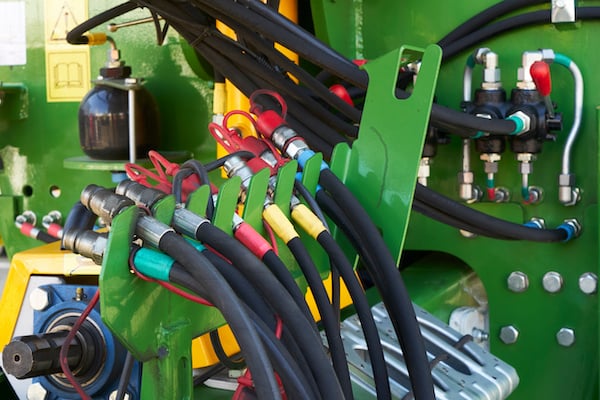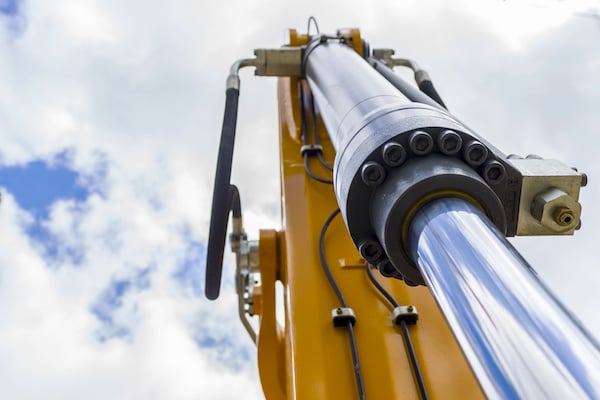Hydraulic component and system technology continues to evolve, enabling industrial machinery and heavy equipment to work more efficiently.
The benefits of hydraulic transmission systems’ large force output, high power density and ease in driving linear motion will remain the viable choice in mobile and industrial hydraulics well into the foreseeable future.
There are currently many significant advancements in the integration of electronics into hydraulic systems. In many applications, electrohydraulic components provide a high degree of scalability, accuracy and overall performance. Electrohydraulic actuators use pressurized hydraulic fluid to operate a valve for providing the system’s force, with the main source of energy being electrical. In electrohydraulic systems, the electronics provide flexibility and control while the hydraulics supply the power.
With a shift toward renewable energy, newer technologies in high-pressure hydraulic systems are becoming more relevant. For instance, electrohydraulic pumps are considered to be up to 80% more efficient than traditional hydraulic systems. Yet traditional hydraulics continue to be the essential systems in cases where flow rate and high pressures need to be controlled. Furthermore, electromechanical systems are too large and cannot provide the force and speed required to power most heavy machinery. Historically, batteries have been cost prohibitive and limiting the equipment’s ability to operate on a single charge for a full day’s work. However, perhaps some of that is changing.
There’s no question that hydraulic cylinders are superior in power density as compared to electromechanical actuators and are likely to remain the go-to source of power for large heavy equipment and machinery for a long time. However, in some applications electromechanical actuators are becoming more prevalent where only low-density power is required- such as many material handling vehicles. Material handling equipment is well positioned to accept newer technologies that require lower power demands and flexible duty cycles, compared to hydraulics or even gas-powered engines.
Long gone are the days of using gas engine forklifts inside a building, due to the carbon monoxide exhaust fumes they produce. Today’s power sources for many indoor and outdoor material handling applications include:
- Propane cylinders
- Electromechanical actuators
- Hydraulic cylinders
- Hydrogen fuel cells
As we strive to be more energy efficient, new developments in equipment electrification are gaining momentum in the off-highway market. Though traditional hydraulics offer superior power density, advancements in electrohydraulic components are beginning to catch up in some applications.
Is the Future Here?
In 2020, Gammon Construction began erecting the Hong Kong Science Park in what was touted as one of its first all-electric construction equipment projects. In 2021, the first zero-emission construction site was underway in Oslo, Norway. The city mandated all construction sites be sustainable by 2025, with the directive that electric or hydrogen heavy equipment be used in all city projects by 2030.
In recent years, many OEM construction equipment manufacturers have started to roll out new electric or hybrid-electric machines. Most are the compact equipment like smaller excavators and forklifts, yet many OEMs are making larger hybrid machines. Companies such as Volvo, Cummins, Komatsu and Doosan Bobcat are introducing electric or hybrid frontend loaders, forklifts, excavators and more. Additionally, John Deere announced they will be “introducing zero-emissions electric options and hybrid-electric solutions to new fields of work by 2026.” Monarch Tractor is focused on revolutionizing the agricultural industry with electric, autonomous technologies to build clean farming equipment.
Electric and hybrid heavy equipment has several benefits, including a reduction in greenhouse gasses, noise, operating and energy costs.
Yet is it a Catch-22? – Cleaner Energy at What Cost
According to an article in Industry Week, “Once in operation, electric cars certainly reduce your carbon footprint, but making the lithium-ion batteries could emit 74% more CO2 than for conventional cars.” And that’s just cars. The most widely used batteries for excavators and other construction equipment are LiFe PO4 and Lithium NMC.
Mining lithium and manufacturing lithium-ion batteries for electric vehicles requires far more energy and is more material-intensive than making traditional gas or diesel engines. The energy used to extract and process lithium comes from CO2-emitting fossil fuels. This is particularly the case in the predominant method of hard rock mining where every ton of lithium mined emits 15 tons of CO2 into the air.
The mining and use of materials for manufacturing lithium-ion batteries has shown the potential to cause 15% of global warming and 10% of the potential cause of human poisoning.
Mining of lithium primarily occurs in Chile, Australia, Argentina and China. Yet the consumers of lithium and leaders in lithium-ion battery production are China and various European countries. This includes Germany who is planning to become the second largest manufacturer of lithium-ion batteries in the world by 2025, just behind China who exports 20% of their production.
In short, 85% of the world’s lithium is mined in the southern hemisphere, with most of its consumption going to countries in the northern hemisphere.
Conclusion
As newer technologies evolve, hydraulic systems will become more efficient and autonomous, electric and hybrid heavy equipment will continue to enter the market, particularly as the development of battery technologies becomes more environmentally friendly.
Regardless of the trends in electrification, electric cylinders and motors are not likely to be made compact and powerful enough to replace hydraulics. Unlike its electric equivalent, a 100 hp hydraulic axial piston motor can fit into your desk drawer.
Hydraulics will continue to be the major source of power for most large heavy equipment that requires the power density to move large loads for the foreseeable future. This includes the bed of large haul trucks, garbage trucks and the blade of a bulldozer. Additionally, they are not likely to be replaced any time soon in industrial equipment such as forging presses, in offshore equipment, many aerospace applications or anywhere where a large amount of force or power density is necessary.
Sources Include:
